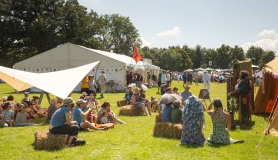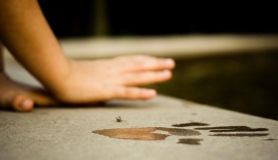Why upcycle outdoors? At a guess I would say that upcycling in its most raw form probably originated outdoors, not for aesthetic reasons or to create a statement, but out of necessity. I remember vividly my parents using two small repurposed, modified plastic drinks bottles as hoppers to dispense slug repellent, and empty yoghurt pots filled with fat and seeds to feed the birds.
In the ‘50s and ‘60s we didn’t own lots of shiny possessions, store cards didn’t exist and you couldn’t just buy furniture and cars on easy credit, so we made do with what we had, repaired it if it broke and looked after it to ensure it lasted.
Gardens have never seen that much design attention. They used to be regarded as places to kick a ball, grow some veg or build a shed to house the lawnmower. Now, however, thanks to ever-increasing house prices, rather than moving, habitants are spilling out of their homes and into outdoor spaces, creating sanctuaries of relaxation, from a courtyard to unwind in after a hard day’s work to a balcony to open onto at dinner parties.
If you need even more evidence just look at the current trends in interiors: gold pineapples adorn dining tables, pink flamingos are on fabrics and wallpapers, while cactuses and air plants have never seen so much popularity. Urban jungle is everywhere; bringing the outside in is the current architectural must-have, and biophilic design (the addition of natural materials, textures and increased natural light into an interior - particularly urban spaces) is visible in all the big creative offices.
I feel that, traditionally speaking, products for the garden have been less design-led and more functional and practical. However, that is changing. Gone are the days of outdoor wood preservatives being only available in sludge brown, puddle brown or yuck brown – we are seeing a wonderful array of colourful paints and waxes. Placing items in the garden usually used exclusively inside our homes has also become popular, and this can create a very magical, fairytale look to our outdoor space.
MAKE YOUR OWN CHAIR SWING
- As we grow up there are some activities we loved to do as children that society tells us we shouldn’t indulge in any more as adults - swinging is one of those pastimes. What better item to use to create a swing that is as comfortable for adults to use as for children than an old wooden pub chair?
Pub chairs, usually an unappealing dark brown and smelling a bit of stale beer, look a bit sad. But they are structurally sound, have gorgeous curves and are ergonomically perfect. This project celebrates these qualities and adds a contemporary twist in terms of both style and purpose – this swing functions as well as it looks!
By attaching rustic rope and chopping the legs, you can turn a once unloved chair into a fun and enjoyable piece of garden furniture for years to come.
Kids will suddenly realize that you can have a lot of fun without the need for technology and touch screens!
ITEMS TO SOURCE:
- old wooden chair
- strong, thick rope
- exterior chalk paint
- Danish oil
- MARK OUT CUTS - Mark cutting lines on all four legs and the back rest. Draw around something circular – I used some handy masking tape – to get two matching curves.
- TRIM LEGS - Reduce the length of the legs using a hand saw, then sand the bases smooth. TIP: Use your thumb as a steady rest for the saw blade.
- REDUCE BACK REST - Saw away the two outer back spindles using a Japanese saw, hand saw or an electric saw.
- ADD ROPE AND SAND - Measure and drill four holes for the rope, making sure they are balanced on either side. If possible drill through the holes left by the spindles. Sand all over, then brush off the dust. Paint the legs and spindles with outdoor chalk paint. Apply Danish oil to the seat base and back rest to nourish and protect the wood. Tie rope through the holes and onto a branch using a good secure knot. Trim the back rest following the marked lines using a coping saw, then sand smooth.
MORE INSPIRATION
READ Upcycling Outdoors by Max McMurdo, £20 Jacqui Small
WATCH Garth Jones TED Talk on recycled crafts at youtube.com/watch?v=Ez4pMe8M4hM
EXPLORE More about Max’s work at maxmcmurdo.co.uk







